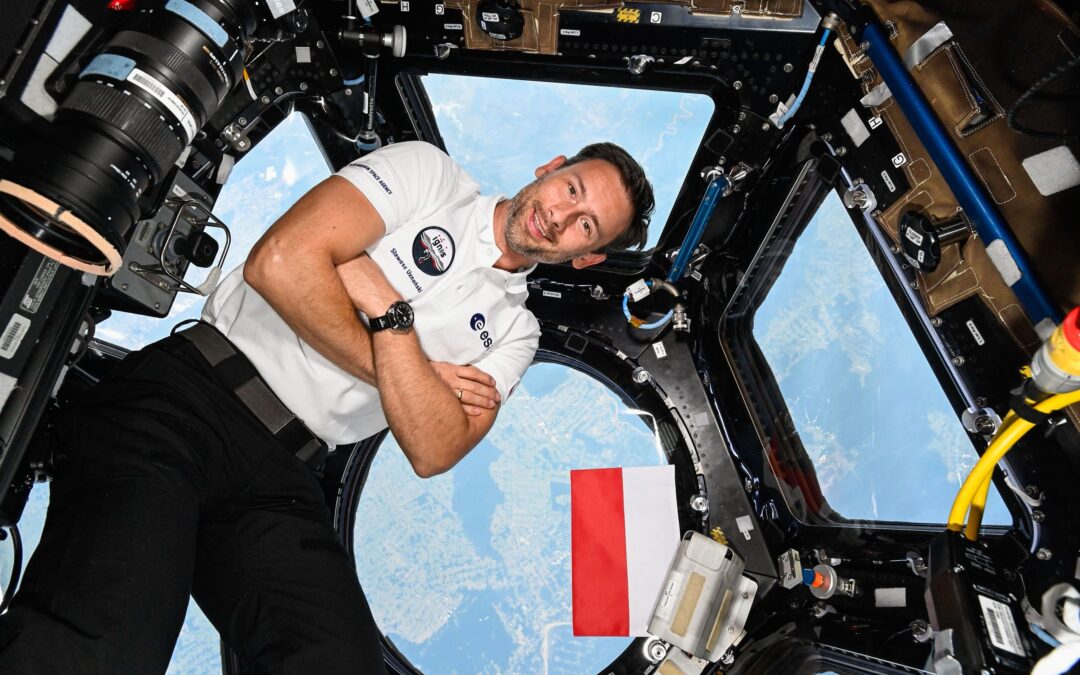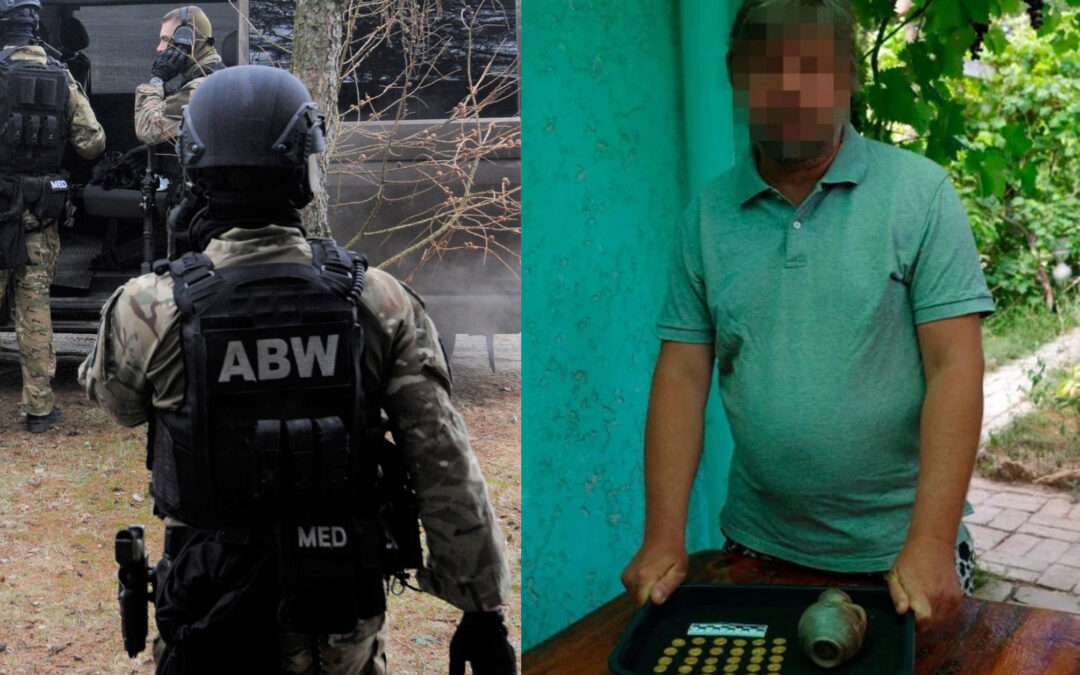Keep our news free from ads and paywalls by making a donation to support our work!

Notes from Poland is run by a small editorial team and is published by an independent, non-profit foundation that is funded through donations from our readers. We cannot do what we do without your support.
By Wojciech Brzeziński
A roar shook the Florida coast in June, as a Falcon 9 rocket shot skyward. Inside the SpaceX Dragon capsule sat Sławosz Uznański-Wiśniewski, Poland’s first spacefarer in almost half a century.
Not since 1978, when Mirosław Hermaszewski flew on a Soviet mission to the Salyut space station, had a Pole been to space. “Nearly two generations have waited for this moment,” declared Krzysztof Paszyk, Poland’s then development minister.
The first ever Polish mission to the International Space Station launched today from NASA’s Kennedy Space Center aboard a SpaceX rocket.
It is being led by astronaut Sławosz Uznański-Wiśniewski, who has become just the second Pole to travel to space https://t.co/DNnSKctleA
— Notes from Poland 🇵🇱 (@notesfrompoland) June 25, 2025
When Uznański floated into the ISS as part of the IGNIS mission, Poles saw tangible proof that their country had rejoined the exclusive club of spacefaring nations. During his two-week stay, the astronaut conducted 13 scientific experiments devised by Polish researchers, from testing AI algorithms in microgravity to studying spaceflight’s effects on the human psyche.
“The IGNIS mission proves that Poland is no longer just a participant in global space missions, but a co-creator,” said Marta Ewa Wachowicz, head of Poland’s Space Agency (POLSA).
For a country whose role in space had long been limited to building components for others, it was a defining milestone and the clearest sign yet that Poland’s fast-evolving space industry is truly reaching for the stars.
From cosmic bystander to budding space player
After the Cold War, Poland’s space activities were modest and piecemeal. A research instrument here, a subcontract on a European satellite there.
The real turning point came in 2012, when Poland joined the European Space Agency (ESA) as a full member. ESA membership opened the doors to the cosmos: Polish universities and firms could bid on international projects, tap into technical know-how, and dream bigger, assisted by an increase in private investment in space tech.
Nonetheless, well into the 2010s Poland remained mostly an afterthought to the big players. It built parts – circuit boards, hammers, software, scientific instruments – that powered other nations’ missions.
That began to change in the 2020s. In August 2024, engineers at Warsaw-based Creotech Instruments cheered as EagleEye, a 50-kilogram microsatellite designed entirely in Poland and the country’s largest ever satellite, deployed into low-Earth orbit.
The largest and most technologically advanced Polish satellite to date successfully reached orbit on Friday.
It will provide high-resolution images that can be used by various sectors, from agriculture to the militaryhttps://t.co/SnCasAYJkb
— Notes from Poland 🇵🇱 (@notesfrompoland) August 19, 2024
Importantly, EagleEye was a Polish-led design. The project was managed by POLSA and a consortium of domestic companies: Creotech as prime contractor, Wrocław’s Scanway supplying the on-board telescope, and the Space Research Centre of the Polish Academy of Sciences contributing the computer system.
For the first time, Poland had gone end-to-end: from drawing board to clean room to launch pad. The successful flight of EagleEye was hailed as a historic breakthrough, evidence that the country could not only make parts, but build whole spacecraft.
“We can say that there is a revolution in the Polish space sector,” said Łukasz Wilczyński, a space expert, after a string of such successes in 2024.
That revolution’s ethos is technological sovereignty. “As a country, especially a frontline country…we need our own devices of this type,” he explained, pointing to EagleEye’s high-resolution Earth imaging as a dual tool for science and security.
The EagleEye milestone was quickly followed by others. That same summer, a small experimental rocket dubbed Bursztyn (Amber) blasted off from a military airfield and briefly crossed the threshold of space – the first time a Polish-made rocket had officially done so (there is a strong possibility that milestone was first achieved in the communist era but was suppressed by Poland’s Soviet overseers in Moscow).
Around the same time, a startup from Gliwice called KP Labs celebrated receiving the first data from Intuition-1, a satellite it built with an AI-powered processor to analyse images in orbit.
Meanwhile, the Wrocław firm Scanway had its vision system flown on the inaugural launch of Europe’s new Ariane 6 rocket, providing critical in-flight data to ESA – a proud showcase of Polish tech on the global stage.
After years in which Poland’s presence at major space conferences was scant, suddenly dozens of Polish companies were turning heads from Colorado to Paris. And for the first time since the fall of communism, Poland will in 2027 host the International Astronautical Congress, a significant space event on the global stage.
A European mission leader
Driving this rapid ascent are Poland’s ambitious homegrown firms and the new opportunities they have seized. Creotech Instruments, once a tiny Warsaw startup, is now the country’s flagship space company.
Under CEO Grzegorz Brona (a former CERN physicist and ex-POLSA chief), Creotech led the EagleEye project and in April 2025 clinched a €52 million ESA contract – the largest such deal signed with a Polish firm – to build Project CAMILA, a constellation of at least three Earth observation satellites, by 2027.
Winning the CAMILA deal as prime contractor cemented Poland’s transition from junior partner to mission leader. “It’s a win that shows how far Poland’s space industry has advanced – and how much faster it’s moving now,” Brona told Warsaw Business Journal.
The European Space Agency has signed its largest ever contract with a Polish firm.
Under the €52m deal, Creotech Instruments will launch a constellation of Earth observation satellites intended to strengthen national security and monitor the environment https://t.co/Ay3ScFpyXO
— Notes from Poland 🇵🇱 (@notesfrompoland) April 16, 2025
Another rising star is SatRev, a Wrocław-based venture building nanosatellites. Founded in 2016, SatRev has already put over a dozen of its shoebox-sized satellites into orbit and even delivered spacecraft for international partners from Oman to the United States. It is now constructing a mass production facility capable of turning out hundreds of nanosats per year.
There is also ICEYE, a Finnish-Polish company with one of its main R&D and manufacturing hubs in Warsaw, which pioneered microwave radar imaging from microsatellites. ICEYE’s constellation of small radar satellites – 54 and counting – can see the Earth at night and through clouds, a capability so valuable that Ukraine has relied on it for battlefield intelligence in its war against Russia.
Over the past decade, Polish entities have contributed to flagship ESA missions: building instruments for the Rosetta comet probe, developing software for ExoMars, and providing critical components for Copernicus Earth-monitoring satellites.
Those experiences laid the groundwork. Now, with Warsaw sharply increasing its financial stake in ESA programmes – from an initial €132 million for 2023–25 to an additional €200 million in optional programmes – the country is buying itself a bigger seat at the table.
The hope among industry insiders is that more money invested will mean more high-profile roles for Polish teams. At the same time, they caution that a clear plan is also necessary.
Policy, pride and the shadow of war
Poland’s space sector is still struggling with growing pains, and the geopolitical environment has only raised the stakes. Industry leaders frequently lament the lack of a clear national space programme to tie together the country’s efforts.
While the government has adopted a Polish Space Strategy with lofty goals – aiming for a 3% share of Europe’s space economy by 2030 and even proposing a Polish moon mission by that date – turning those ambitions into reality has proven tricky. Although a detailed national space programme was drafted, it never got off the ground due to funding squabbles and shifting political priorities.
A Polish rocket has become the first to reach space using a pioneering type of more environmentally friendly fuel https://t.co/PRTOVymS8r
— Notes from Poland 🇵🇱 (@notesfrompoland) July 5, 2024
However, some industry leaders think that might be a blessing in disguise, since the original draft was far behind the actual trajectory of the Polish space sector.
“If we stuck to the plan, we would still be limited to building minor components for other people’s spacecraft instead of the satellite factories we actually have now,” an industry leader told Notes from Poland.
However, without a clear roadmap, there is a concern that Poland might spread itself too thin, or miss out on making the most of the new funds.
Meanwhile, Russia’s full-scale invasion of Ukraine has vividly demonstrated how satellites can make the difference on the battlefield, providing secure communications – such as that offered by Elon Musk’s Starlink terminals – and real-time imagery to track troop movements or document war crimes.
It has also exposed vulnerabilities, with Europe finding itself scrambling when faced with gaps in satellite navigation, surveillance and broadband coverage, especially after ties with Russia were severed.
Suddenly, policymakers in Warsaw and Brussels saw how perilous it was to depend on non-European providers for critical space services. In this new geopolitical reality, “sovereign space capabilities have moved from ‘nice-to-have’ to essential,” Brona stressed in a Warsaw Business Journal interview.
Polish business and political leaders could not agree more. They view building a robust space sector as vital to national security and resilience.
"The first Polish satellites will be launched into orbit in November," the defence minister has announced during the opening of Poland's first satellite mission control centre.
The devices will further bolster the country's security, says @KosiniakKamysz https://t.co/hSVaeM0r2S
— Notes from Poland 🇵🇱 (@notesfrompoland) August 29, 2025
That is one reason why Poland has doubled down on projects like MikroGlob (a planned Polish military satellite network for reconnaissance, under Creotech’s purview) and PIAST (a trio of nanosatellites set to test encrypted laser communications for the army).
The latter, developed with the Military University of Technology, are scheduled to launch in late 2025 to demonstrate a wartime-proof “laser mesh” between satellites and the ground, immune to jamming or detection.
Poland’s space ambitions also dovetail with a broader push by the European Union for technological sovereignty. Brussels has been rolling out programmes for EU-made launchers, satellite constellations (like the forthcoming IRIS² secure communications network), and greater investment in space startups.
As a fast-growing economy with a foot in both eastern and western Europe, Poland is eager to be seen as a leader in this effort. And in 2021, Poland signed on to the Artemis Accords, a US-led framework for international cooperation on returning to the moon.
By aligning with NASA’s Artemis programme, Poland hopes to secure a role – however small – in lunar exploration, whether by contributing components to the Lunar Gateway space station or developing its own lunar science instruments.
As NASA and Europe gear up for a permanent moon presence within the next decade, Warsaw clearly does not want to be left behind – and its efforts suggest that Poland is now able to play an important part in the new space race.
Polish space agency signs deal with NASA for “exploration of Moon, Mars and beyond” https://t.co/yfntgRvBP5
— Notes from Poland 🇵🇱 (@notesfrompoland) October 28, 2021

Notes from Poland is run by a small editorial team and published by an independent, non-profit foundation that is funded through donations from our readers. We cannot do what we do without your support.
Main image credit: ©ESA/S. Uznański-Wiśniewski



















